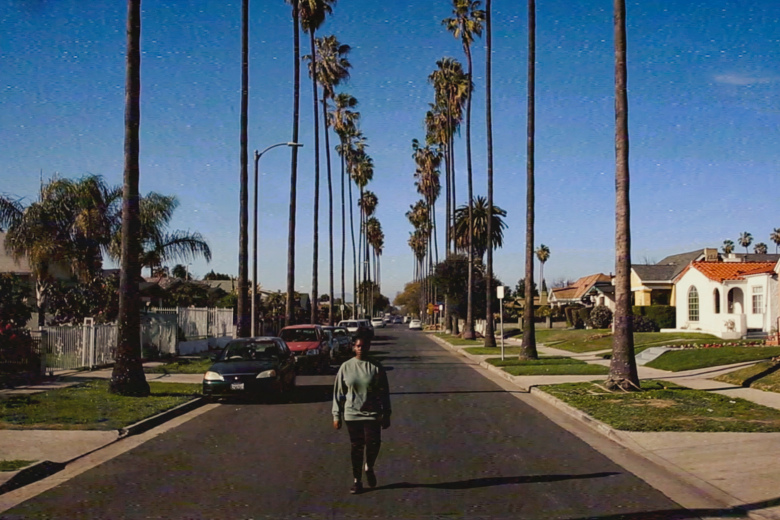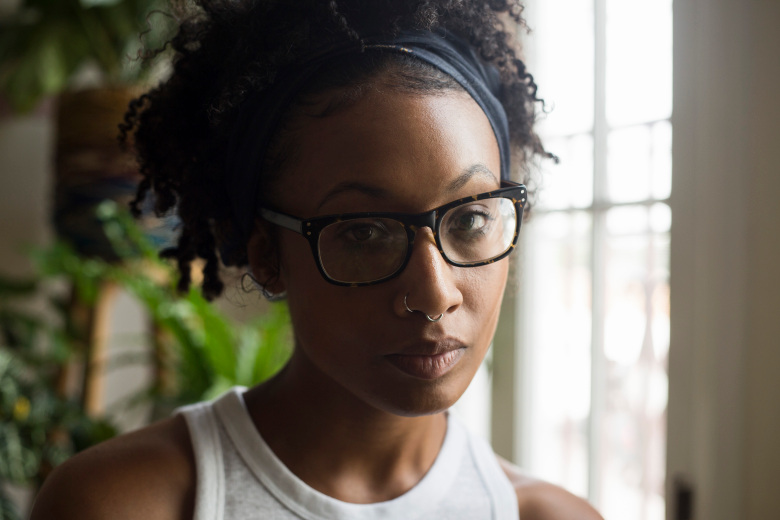“A Love Song For Latasha” delivers on the promise of its title: This arresting documentary short is a lyrical celebration of the life of Latasha Harlins, the 15-year-old girl from South Central Los Angeles whose 1992 shooting death became a flashpoint in the LA uprisings. While the Black community that mourns her to this day will recall the grainy footage of her death, which circulated widely on news stations at the time, the footage is nowhere to be seen in “A Love Song for Latasha.” On the contrary, the 19-minute film is bursting with sun-kissed sidewalks and faded basketball courts, clean line animation and radiant Black girls posed gracefully, like young queens.
The visionary film made the Cinema Eye Honors Shorts List, an IDA nomination for Best Short, and the Grand Jury Prize for Best Documentary Short at AFI Fest. Filmmaker Sophia Nahli Allison was singled out by DOC NYC for Best Direction in its shorts competition. “A Love Song for Latasha” was picked up for distribution by Ava DuVernay’s ARRAY Releasing, which is how it got to Netflix. With considerable industry support for its bold and imaginative take on a vital subject, “A Love Song for Latasha” should be a strong contender for awards consideration.
Beginning with an anecdote from her childhood best friend Ty, who met Latasha when she jumped fully clothed into a pool to protect Ty from some neighborhood boys, the film paints a vivid picture of Latasha as a selfless, ambitious, and confident young girl. She was “the neighborhood big sister” with dreams of becoming a lawyer; she missed the way her late mom smelled; she was a fiercely loyal friend. A detailed portrait of Latasha emerges in striking detail, using only voiceover from Ty and Latasha’s cousin Shinese. Filmmaker Sophia Nahli Allison was adamant about not using the shooting footage, and set about re-creating Latasha’s world through a cinematic lens.
“From the beginning, we knew we did not want to incorporate that footage. We did not feel it was important to show her death to prove how important her life was, and not needing to show trauma of the black body,” Allison said during a recent interview. “I knew that there was no archival footage for me to pull from, so I was thinking: What does it mean to reimagine or rebuild an archive when that tangible evidence doesn’t exist, and how often that happens for Black women and girls, when their stories and their histories haven’t been properly preserved outside of oral history?”

“A Love Song for Latasha”
Courtesy of Netflix
Though the film is a documentary, it features none of the traditional talking head shots or archival footage typical of the genre. Allison shot everything in the film, using girls from the neighborhood as stand-ins for Latasha and her friends. No single actress portrays Latasha, and most of the girls had never acted before.
“I don’t like to call them recreations — I call it a spiritual archive, or a re-imagining of who Latasha is, because I wanted it to feel as authentic as possible,” said Allison. “I wanted the experience to feel non-linear, to feel like Latasha could have been any of us, for those watching to identify with Latasha as this revolving image of a young black girl.”
As for the imagery of South Central, where Allison was raised, she imbues the neighborhood with the beauty and life she saw growing up. She wanted to challenge the perception of South Central as a place of violence and gangs; instead viewing it as “a character in the film” and “a landscape that was this sanctuary for these black girls.”
“[I wanted] to juxtapose and challenge how we remember South Central, how we think about it, and what our initial reaction is to a Black community, and allowing it to be more of a peaceful haven rather than just this urban landscape that people assume it to be,” she said. “So letting there be that magical realism within South Central. We wanted it to be this place where Black girls come and see themselves represented beautifully, where they can see themselves reflected, where they can feel held on this journey and allow for this peace and magic to surround them.”

“A Love Song for Latasha” filmmaker Sophia Nahli Allison
Courtesy of the filmmaker
When the film finally reaches the day of the shooting, clean line animations populate the screen where the grocery store footage might have gone. A flurry of seemingly disparate images flash across the screen; a moving truck in reverse, a tear falling down a woman’s cheek. The black and white static of a VHS tape intercuts the visuals, slicing them down the middle and interrupting the flow. Simple sound design amplifies the moving effect, as we hear the crackling static of memory rewinding, fading, and shifting before our eyes.
“We wanted it to be very minimalistic, to feel like you were traveling through a dreamscape, traveling through memories,” said Allison. “How does trauma impact our memories? So there are moments where the image starts to break up, because I’m thinking about what happens when we’re trying to revisit a memory that has been painful, how do we try to protect ourselves? How does the image become blurry? How does the image sometimes change?”
The VHS effect was also a reckoning with the absence of the footage of Latasha’s death. Allison thought about the home movies from her own childhood, and what an archive of Latasha’s life might have looked like.
“I wanted it to feel like this intimate home movie that was created for Latasha by the family. And so disrupting and playing with this idea of, this is the footage that does exist with Latasha, it is grainy footage, but what happens if we use that grain, we use that aesthetic, and we re-imagined how this could have been used to document who she was, to record her life, to record her memories and her dreams, and what it meant to be a young black girl in LA.”
“A Love Song for Latasha” is currently streaming on Netflix.
The visionary film made the Cinema Eye Honors Shorts List, an IDA nomination for Best Short, and the Grand Jury Prize for Best Documentary Short at AFI Fest. Filmmaker Sophia Nahli Allison was singled out by DOC NYC for Best Direction in its shorts competition. “A Love Song for Latasha” was picked up for distribution by Ava DuVernay’s ARRAY Releasing, which is how it got to Netflix. With considerable industry support for its bold and imaginative take on a vital subject, “A Love Song for Latasha” should be a strong contender for awards consideration.
Beginning with an anecdote from her childhood best friend Ty, who met Latasha when she jumped fully clothed into a pool to protect Ty from some neighborhood boys, the film paints a vivid picture of Latasha as a selfless, ambitious, and confident young girl. She was “the neighborhood big sister” with dreams of becoming a lawyer; she missed the way her late mom smelled; she was a fiercely loyal friend. A detailed portrait of Latasha emerges in striking detail, using only voiceover from Ty and Latasha’s cousin Shinese. Filmmaker Sophia Nahli Allison was adamant about not using the shooting footage, and set about re-creating Latasha’s world through a cinematic lens.
“From the beginning, we knew we did not want to incorporate that footage. We did not feel it was important to show her death to prove how important her life was, and not needing to show trauma of the black body,” Allison said during a recent interview. “I knew that there was no archival footage for me to pull from, so I was thinking: What does it mean to reimagine or rebuild an archive when that tangible evidence doesn’t exist, and how often that happens for Black women and girls, when their stories and their histories haven’t been properly preserved outside of oral history?”

“A Love Song for Latasha”
Courtesy of Netflix
Though the film is a documentary, it features none of the traditional talking head shots or archival footage typical of the genre. Allison shot everything in the film, using girls from the neighborhood as stand-ins for Latasha and her friends. No single actress portrays Latasha, and most of the girls had never acted before.
“I don’t like to call them recreations — I call it a spiritual archive, or a re-imagining of who Latasha is, because I wanted it to feel as authentic as possible,” said Allison. “I wanted the experience to feel non-linear, to feel like Latasha could have been any of us, for those watching to identify with Latasha as this revolving image of a young black girl.”
As for the imagery of South Central, where Allison was raised, she imbues the neighborhood with the beauty and life she saw growing up. She wanted to challenge the perception of South Central as a place of violence and gangs; instead viewing it as “a character in the film” and “a landscape that was this sanctuary for these black girls.”
“[I wanted] to juxtapose and challenge how we remember South Central, how we think about it, and what our initial reaction is to a Black community, and allowing it to be more of a peaceful haven rather than just this urban landscape that people assume it to be,” she said. “So letting there be that magical realism within South Central. We wanted it to be this place where Black girls come and see themselves represented beautifully, where they can see themselves reflected, where they can feel held on this journey and allow for this peace and magic to surround them.”

“A Love Song for Latasha” filmmaker Sophia Nahli Allison
Courtesy of the filmmaker
When the film finally reaches the day of the shooting, clean line animations populate the screen where the grocery store footage might have gone. A flurry of seemingly disparate images flash across the screen; a moving truck in reverse, a tear falling down a woman’s cheek. The black and white static of a VHS tape intercuts the visuals, slicing them down the middle and interrupting the flow. Simple sound design amplifies the moving effect, as we hear the crackling static of memory rewinding, fading, and shifting before our eyes.
“We wanted it to be very minimalistic, to feel like you were traveling through a dreamscape, traveling through memories,” said Allison. “How does trauma impact our memories? So there are moments where the image starts to break up, because I’m thinking about what happens when we’re trying to revisit a memory that has been painful, how do we try to protect ourselves? How does the image become blurry? How does the image sometimes change?”
The VHS effect was also a reckoning with the absence of the footage of Latasha’s death. Allison thought about the home movies from her own childhood, and what an archive of Latasha’s life might have looked like.
“I wanted it to feel like this intimate home movie that was created for Latasha by the family. And so disrupting and playing with this idea of, this is the footage that does exist with Latasha, it is grainy footage, but what happens if we use that grain, we use that aesthetic, and we re-imagined how this could have been used to document who she was, to record her life, to record her memories and her dreams, and what it meant to be a young black girl in LA.”
“A Love Song for Latasha” is currently streaming on Netflix.


